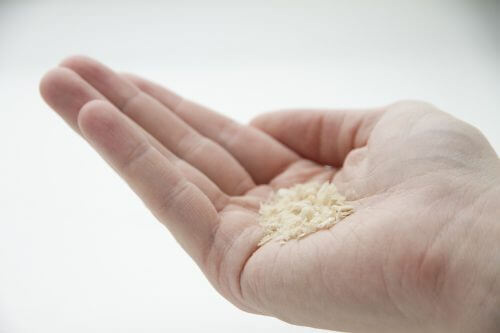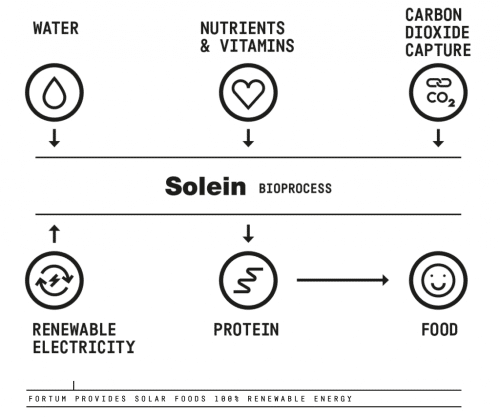A new technological venture hopes to revolutionize the food market and produce edible protein in a creative way that will significantly reduce the damage to the environment
Ran Ben Michael, Angle - Science and Environment News Agency
The cleantech field in the Nordic countries has been growing in the last two years. The combination between public awareness of the global environmental crisis and the availability of investments from the European Union allows new ideas to develop. One of the most interesting of them - and with revolutionary potential (in theory, at least) - is a biotechnology start-up from Finland that found a way to produce edible protein from carbon dioxide from the air, water and electricity.
The project, called Solar Foods, was launched with an investment of about 2 million euros to develop a process that would deal with the need to disconnect a certain part of food production from the negative environmental effects of agriculture and the dependence of agricultural production on the changing climate.
engine of climate change
Agriculture is one of the main engines of climate change: about a fifth of all emissions in the world are attributed to agricultural activity and the change in land use intended for it. On the other hand, global warming is changing agricultural practice and its products: for example, less harvest and poorer quality. The main inputs for agriculture - land and water - are depleting and almost all the land suitable for agricultural cultivation is already used today and the supply of fresh water available for agricultural use is limited. Solutions such as desalination are not satisfactory and in themselves have an additional environmental cost (especially in desalination of seawater which consumes very large amounts of energy). Other inputs - pesticides, fertilizers, antibiotics that are used in livestock - cause damage to the environment and public health, and their production processes also involve significant emissions of greenhouse gases.
Most of the damage is caused by raising animals for meat, partly because a lot of food has to be grown for them as well. Only about 17 percent of the calories consumed by humans around the world are obtained from meat and milk, but raising animals takes up 80 percent of the land for agriculture (mainly for the purpose of growing food for the animals and pasture). The world's population is still growing at the rate of an additional billion people every 12 years, and some claim that it is expected to stabilize in about 50 years, by which time many more mouths need to be fed sustainably. Protein from the sea will probably not be able to meet the future demand volumes since the amount of fish is decreasing, and aquaculture is not enough to keep up with the demand (and it is of course exposed in a different way to difficulties similar to those of agriculture on land). The road to a significant use of a protein source based on insects is still long, even though many hopes are attached to it.
There are organizations that invest in dealing with some of the causes of the problem. Thus, for example, Tyson, the second largest company in the meat sector, announced the launch of a poultry house whose energy source is solar. But such a solution is indeed only partial. What can change the picture dramatically is a protein substitute with a low environmental footprint and high nutritional value.

Solar Foods nutritional powder. Photo: Solar Foods
A breakthrough solution
The system developed by the new Finnish enterprise is completely disconnected from the ground and a process similar to a brewery takes place in it, except that instead of sugar and yeast, the process corresponding to fermentation takes place by bacteria that feed on hydrogen - produced through electrolysis of water (passing an electric current in water using electrodes and breaking it down into oxygen and hydrogen) - and carbon dioxide and nitrogen (adsorbed from the air). To this are added vitamins and minerals that help microorganisms to produce a high protein content.
Drying the liquid at the end of the process leaves a flour-like powder, called saline, which contains 50 percent protein, 25-20 percent carbohydrates and 10-5 percent fat. According to the company, this process is much more efficient, at least ten times more in utilizing water and land than growing soybeans, according to the company's publications.
Another interesting point is that there are a large number of such microorganisms, which are an inexhaustible source for the production of different types of protein with many nutritional qualities (for example, different compositions of amino acids, the basic units of which proteins are composed, some of which are considered vital because our bodies do not know how to produce them) .
Compared to the great potential that apparently lies in the new development, contemporary agriculture is not at all diverse: we know of almost 300 species of edible plants, but only 200-150 of them are grown commercially. A total of 17 species (12 plants and 5 animals) contribute 75 percent of production and three plant species contribute 60 percent of our calories (corn, rice and wheat). This is in fact a complete lack of independence (on the basis of these data Prof. Yuval Noah Harari claimed in his book "Summary of the History of Mankind" that wheat domesticated man - and not the other way around).
An equal price for everyone?
One kilogram of saline powder should provide the protein intake of seven to ten people per day. The company anticipates that the price for the consumer will be competitive relative to other foods and this is the key point: in order to deal with the food crisis in a sustainable manner, affordable food must also be provided in terms of costs. According to the company's publications and statements, the price of the product will be 5 euros (about NIS 20) per kilo, this may sound relatively cheap, but it is worth remembering that this is also the daily salary of about half of the world's population (as of 2015).
If and when Solar Foods' product receives the approval of the European Food Safety Agency (the company is also seeking approval in Europe as an innovative food) it plans to move to a production plant that is planned to produce food to the extent of 50 million meals per year as early as the end of 2021. The company's current running plant (pilot) is powered by electricity produced in a hydroelectric station that produces electricity from the flow of water, which, like any modern method of producing energy, is not without environmental effects. As the electricity consumed by the future production plant is produced from cheap and renewable sources (solar, wind, water, etc.), the benefits of the system will only increase, its environmental effects will be reduced and production costs may also decrease.
By the way, Solar Foods is not alone in the field. Kiverdi uses a similar technology to produce basic products for the food market. NovoNutrients and DeepBranch are also developing processes for the production of similar food, mainly for the aquaculture market, in order to deal with the weak point of this sector: a lack of cheap and effective food for raising predatory fish (such as tuna). However, the Finnish enterprise is apparently one of the few that are aimed at mass consumption for humans.

powder for space
The protein powder (which is also vegan, of course) has another advantage: because of the separation from the dependence on the ground, this process can also take place in space and provide food for astronauts. Indeed, the European Space Agency wants to use the technology on flights to Mars and the venture is part of the agency's business incubator.
Thus, it is possible that this solution could, thanks to the modest inputs and disconnection from the need for land, provide food in places on earth that are not suitable for agricultural cultivation. If the company passes the regulatory test, its promises to produce at a relatively low cost per kilogram of animal protein and the public's choice, perhaps this powder will become a real solution on the way to a new food industry.

2 תגובות
Take these bacteria and put them in the digestive system of the animal/man and he will never have to eat again in his life. The bacteria will produce everything he needs. Max will drink soda to provide carbon dioxide.
If eggs and milk are not vegan and honey is not vegan, are the excretions of bacteria also not vegan?